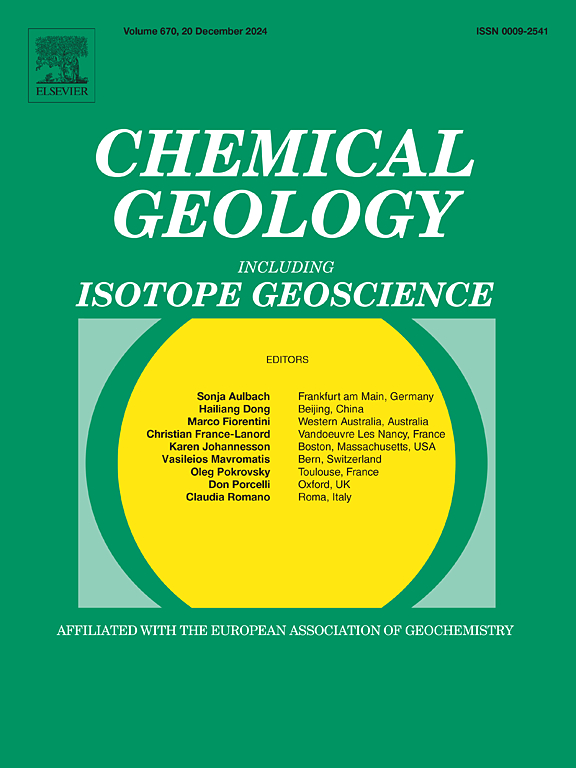喜马拉雅浅长花岗岩中流体-熔体相互作用记录的稳定锶同位素分馏
IF 3.6
2区 地球科学
Q1 GEOCHEMISTRY & GEOPHYSICS
引用次数: 0
摘要
花岗岩岩浆的演化是大陆地壳组成分异的一个重要过程。稳定的Sr同位素组成(δ88Sr)在分馏结晶过程中可能发生明显的分馏,已被认为是研究花岗岩岩浆演化的有效地球化学示踪剂。然而,稳定的Sr同位素在流体-熔体相互作用中的行为仍然知之甚少。本文研究了喜马拉雅造山带特提斯—喜马拉雅层序中流体相互作用的坎帕浅花岗岩的Sr同位素数据。结果表明,δ88Sr的变化范围为- 1.51‰~ 0.31‰。浅长花岗岩δ88Sr值极低,不能归因于部分熔融、沉积源继承或分异结晶。交代结构等岩石学证据表明,坎帕浅花岗岩经历了明显的流体相互作用。δ88Sr与多个流体活动性指标(Nb/Ta、Y/Ho、TE1、3)的关系表明,较轻的稳定Sr同位素组成与较强的流体活动性有关。具有轻Sr同位素特征的深源富cl流体与演化的花岗岩熔体的相互作用可能是低δ88Sr值的主要原因。因此,稳定的Sr同位素可以为花岗岩体系的晚期演化过程和流体-熔体相互作用提供关键约束。此外,Sr、Ba和Rb稳定同位素之间的相关性表明,流体流动元素的联合同位素示踪可以进一步了解流体活动。本文章由计算机程序翻译,如有差异,请以英文原文为准。
Stable strontium isotope fractionation by fluid-melt interaction recorded in the Himalayan leucogranites
The evolution of granitic magmas represents a crucial process in the compositional differentiation of the continental crust. Stable Sr isotopic composition (δ88Sr), which may undergo significant fractionation during fractional crystallization, has been recognized as an effective geochemical tracer for investigating granitic magma evolution. However, the behavior of stable Sr isotopes during fluid-melt interaction remains poorly understood. In this study, we present Sr isotope data for the fluid-interacted Kampa leucogranite from the Tethyan Himalaya Sequence in the Himalayan orogenic belt. Our results reveal distinct δ88Sr variations (−1.51 ‰ to 0.31 ‰). The extremely low δ88Sr values of the leucogranites cannot be attributed to partial melting, inheritance from the sedimentary source, or fractional crystallization. Petrographic evidence such as metasomatic textures demonstrates that the Kampa leucogranite experienced significant fluid interaction. The relationships between δ88Sr and multiple fluid activity indicators (i.e., Nb/Ta, Y/Ho, and TE1,3) suggest that lighter stable Sr isotopic compositions are associated with intense fluid activity. The interaction between deep-derived Cl-rich fluids with light Sr isotopic signatures and evolved granitic melts is likely the primary cause of the low δ88Sr values. Therefore, stable Sr isotopes can provide key constraints on late-stage evolution processes and fluid-melt interaction in granitic systems. Furthermore, the correlations observed among stable Sr, Ba, and Rb isotopes indicate that combined isotopic tracing of fluid-mobile elements may provide further insight into fluid activity.
求助全文
通过发布文献求助,成功后即可免费获取论文全文。
去求助
来源期刊

Chemical Geology
地学-地球化学与地球物理
CiteScore
7.20
自引率
10.30%
发文量
374
审稿时长
3.6 months
期刊介绍:
Chemical Geology is an international journal that publishes original research papers on isotopic and elemental geochemistry, geochronology and cosmochemistry.
The Journal focuses on chemical processes in igneous, metamorphic, and sedimentary petrology, low- and high-temperature aqueous solutions, biogeochemistry, the environment and cosmochemistry.
Papers that are field, experimentally, or computationally based are appropriate if they are of broad international interest. The Journal generally does not publish papers that are primarily of regional or local interest, or which are primarily focused on remediation and applied geochemistry.
The Journal also welcomes innovative papers dealing with significant analytical advances that are of wide interest in the community and extend significantly beyond the scope of what would be included in the methods section of a standard research paper.
 求助内容:
求助内容: 应助结果提醒方式:
应助结果提醒方式:


